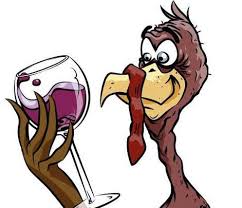
#350 – November 22, 2017
As a wine writer and full-fledged oenophile, the chagim and seasonal weather changes are harbingers not only of wardrobe changes and an onslaught of meat-heavy grocery shopping but also curated wine and drinking adjustments. With good wine playing a primary role in the positive vibe of any social gathering or festive meal, it shouldn’t be a surprise to anyone that wine selection takes up a significant amount of any good host’s time and effort.
As any reader worth his or her proverbial salt already knows, my general view is that folks should drink wines they enjoy with foods they like. As discussed in my recent article on wine and food pairing, the “right” wine for any particular dish is the wine you are most in the mood for at any given time. However, while the traditional wine-pairing “rules” may “be for the birds,” many of them are built on solid foundations and can be helpful as guidelines (as opposed to being set in stone)
Blame it on the Bird
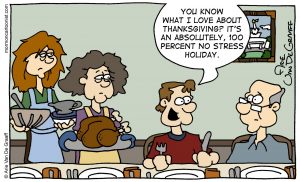 Different from most chagim (other than perhaps Chanukah), the traditional Thanksgiving repast tends to forewarn increased stress levels. While the primary cause of the elevated cortisol levels is usually a specific guest or relative, coming up with proper wine pairings is a common cause as well. In addition to preparing a fowl with which most of us are relatively unfamiliar, a traditional Thanksgiving repast includes a mélange of dishes, with a focus on the turkey and traditionally fall-orientated trimming. While the array of options provides your guests with sufficient choices to satisfy all manner of lifestyle choices, the wide-ranging scope of taste, flavor and texture options can throw a serious wrench in commonly used wine and food-pairing concepts, significantly complicating the wine pairing exercise. Exacerbating the difficulty is the diverse range of palate preferences and oenophilic expertise, virtually guaranteed by the eclectic guest list. Unless you are having an intimate meal where all participants are fellow wine lovers, Thanksgiving dinner usually isn’t the best place to showcase meticulous wines pairings.
Different from most chagim (other than perhaps Chanukah), the traditional Thanksgiving repast tends to forewarn increased stress levels. While the primary cause of the elevated cortisol levels is usually a specific guest or relative, coming up with proper wine pairings is a common cause as well. In addition to preparing a fowl with which most of us are relatively unfamiliar, a traditional Thanksgiving repast includes a mélange of dishes, with a focus on the turkey and traditionally fall-orientated trimming. While the array of options provides your guests with sufficient choices to satisfy all manner of lifestyle choices, the wide-ranging scope of taste, flavor and texture options can throw a serious wrench in commonly used wine and food-pairing concepts, significantly complicating the wine pairing exercise. Exacerbating the difficulty is the diverse range of palate preferences and oenophilic expertise, virtually guaranteed by the eclectic guest list. Unless you are having an intimate meal where all participants are fellow wine lovers, Thanksgiving dinner usually isn’t the best place to showcase meticulous wines pairings.
That said, and regardless of the copious ink spilled on the topic, successfully incorporating wine into the meal is nowhere near the Herculean task some would have us all believe. As any gathering of friends and family is enhanced with wine, this week’s article sets forth some tips and helpful suggestions for created the exalted environment guaranteed by good wine without any of the accompanying grief created by extra wine-pairing work.
One Inflexible Rule
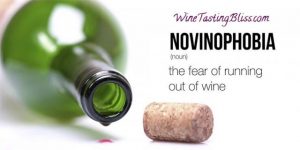 The most important wine rule of any Thanksgiving meal is very simple – don’t run out of wine. I’ve never heard of a family gathering ruined by the Turkey’s chili pepper glaze demolishing the young Bordeaux, but there are few things sadder than empty wine glasses at a festive meal. Having leftover wine is way better that running out mid-meal (half-finished bottles can be sent home with guests as a parting gift or enjoyed during cleanup in your wonderfully quiet, post-meal, home). A wine bottle yields between 4-6 glasses of wine, depending on the pourer’s generosity and I usually recommend buying one bottle per wine-drinking guest. Giving the numerous sweet and savory dishes and diverse range of your guests’ palates and interest in wine, I highly recommend going with a mixed batch of red and white wines, taking into account the considerations listed below. A sparkling wine to start things off works wonders to enhance the festive atmosphere and whet your guest’s appetite for the coming feast, and its versatility ensures you will be enjoying It throughout the meal as well.
The most important wine rule of any Thanksgiving meal is very simple – don’t run out of wine. I’ve never heard of a family gathering ruined by the Turkey’s chili pepper glaze demolishing the young Bordeaux, but there are few things sadder than empty wine glasses at a festive meal. Having leftover wine is way better that running out mid-meal (half-finished bottles can be sent home with guests as a parting gift or enjoyed during cleanup in your wonderfully quiet, post-meal, home). A wine bottle yields between 4-6 glasses of wine, depending on the pourer’s generosity and I usually recommend buying one bottle per wine-drinking guest. Giving the numerous sweet and savory dishes and diverse range of your guests’ palates and interest in wine, I highly recommend going with a mixed batch of red and white wines, taking into account the considerations listed below. A sparkling wine to start things off works wonders to enhance the festive atmosphere and whet your guest’s appetite for the coming feast, and its versatility ensures you will be enjoying It throughout the meal as well.
Helpful Hints
 As opposed to your usual robust dish-laden chag meal, for tomorrow’s dinner you are looking for lighter wines – lighter in alcohol, lighter in body (partially driven by alcohol level) and lighter in tannins. Given the wine range of dishes, the more versatile the wine, the better. For many, these meals are half-day affairs accompanied by near-endless snacking, plenty of drinking and a seemingly inexhaustible parade of relatives prying you’re your personal life. As such, it’s important to serve wines that can go the distance and won’t wear you (and your palate) down early on in the process.
As opposed to your usual robust dish-laden chag meal, for tomorrow’s dinner you are looking for lighter wines – lighter in alcohol, lighter in body (partially driven by alcohol level) and lighter in tannins. Given the wine range of dishes, the more versatile the wine, the better. For many, these meals are half-day affairs accompanied by near-endless snacking, plenty of drinking and a seemingly inexhaustible parade of relatives prying you’re your personal life. As such, it’s important to serve wines that can go the distance and won’t wear you (and your palate) down early on in the process.
Low alcohol can be a subjective term, with younger drinkers considering anything under 14% AbV to fall into that category while more seasoned or older folks considering anything over 12.5% AbV to be an abomination. For our purposes, any wine in the 13% range should suffice and in this case, less is more – the lower the alcohol and the lighter bodied the wine, the better. Focusing lessor tannic wines will ensure you can appreciate the flavors and textures of more delicate dishes and, maintaining versatility as a primary goal, higher-acidity wines will do well with heartier dishes while providing a welcome palate-cleansing refreshingness regardless of what dishes you choose to partake in.
 I’m sure you are all diligently working towards converting all of your friends and family to full-fledged oenophilia and, like me, are experiencing varying levels of success. Regardless, chances are that most participants will be wine challenged to some degree (or worse – self identify as a Blue Bottled Abomination lover). Proper glassware may not be available and it’s unlikely you will be able to properly decant the wines. Together with the inevitable cacophony that usually accompanies such meals, your special (and expensive) bottles aren’t go to be properly appreciated, so avoid the heartache and aim for moderately priced wines. Obviously, if you are lucky to be sharing this special meal with fellow wine lovers, by all means up your game and bring out some better wines, but avoid big, rich and complex wines – even if they would be appreciated, they are going to be bigger wines than appropriate for this type of wine. Save them for a more intimate affair or your local RCC where they can shine in all their vinous glory.
I’m sure you are all diligently working towards converting all of your friends and family to full-fledged oenophilia and, like me, are experiencing varying levels of success. Regardless, chances are that most participants will be wine challenged to some degree (or worse – self identify as a Blue Bottled Abomination lover). Proper glassware may not be available and it’s unlikely you will be able to properly decant the wines. Together with the inevitable cacophony that usually accompanies such meals, your special (and expensive) bottles aren’t go to be properly appreciated, so avoid the heartache and aim for moderately priced wines. Obviously, if you are lucky to be sharing this special meal with fellow wine lovers, by all means up your game and bring out some better wines, but avoid big, rich and complex wines – even if they would be appreciated, they are going to be bigger wines than appropriate for this type of wine. Save them for a more intimate affair or your local RCC where they can shine in all their vinous glory.
The Specifics
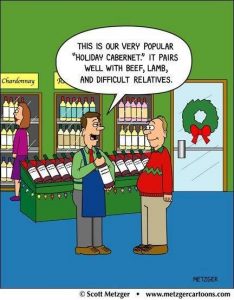 Especially given its well-known versatility, Pinot Noir is an easy choice when searching for a grape varietal most likely to play nicely at your Thanksgiving dinner. The wine’s savory and umami-laden notes of earthy minerals and grilled meat pair exceptionally well with traditional turkey and savory stuffing combinations and the bright acid and rich cherry flavors play nice with lighter dishes that may end up on the sweeter side of the spectrum. Unfortunately quality options remain slim pickings but the there are some decent, currently available options hailing from Burgundy (Domaine d’Ardhuy and Damien Gachot-Monot), California (Hagafen [as the only kosher California winery hit during the fires, supporting them has extra value] and Four Gates) and Israel (Gvaot, Vitkin, Tura and the Golan Heights Winery’s Gamla version).
Especially given its well-known versatility, Pinot Noir is an easy choice when searching for a grape varietal most likely to play nicely at your Thanksgiving dinner. The wine’s savory and umami-laden notes of earthy minerals and grilled meat pair exceptionally well with traditional turkey and savory stuffing combinations and the bright acid and rich cherry flavors play nice with lighter dishes that may end up on the sweeter side of the spectrum. Unfortunately quality options remain slim pickings but the there are some decent, currently available options hailing from Burgundy (Domaine d’Ardhuy and Damien Gachot-Monot), California (Hagafen [as the only kosher California winery hit during the fires, supporting them has extra value] and Four Gates) and Israel (Gvaot, Vitkin, Tura and the Golan Heights Winery’s Gamla version).
Another light-bodied wine that should be a shoo-in for Thanksgiving is Beaujolais. With high acidity, low tannins, lovely fruit and an affordable price; it hits all the criteria for a successful pairing. Unfortunately there are very few acceptable kosher options other than the 2013 Cote De Brouilly (the 2012 was reviewed last year). Other options include Chianti (Italy’s Cantina Giuliano and Terra di Seta), Barbera (Israel’s Shiloh and Ramot Naftali)
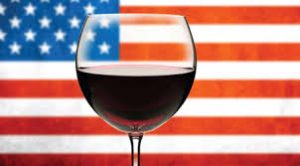 Sticking with red wines, another popular option you hear bandied about this time of year is Zinfandel. Unlike the other wines discussed, Zinfandel’s inclusion is more emotional than practical. Ignoring its murky origins, many consider it to the quintessential American wine, making it perfect for our American holiday of Thanksgiving. However, the varietal’s propensity to yield heavier wines and higher alcohol levels make it hard for me to recommend it as a good option, regardless of the symbolism involved.
Sticking with red wines, another popular option you hear bandied about this time of year is Zinfandel. Unlike the other wines discussed, Zinfandel’s inclusion is more emotional than practical. Ignoring its murky origins, many consider it to the quintessential American wine, making it perfect for our American holiday of Thanksgiving. However, the varietal’s propensity to yield heavier wines and higher alcohol levels make it hard for me to recommend it as a good option, regardless of the symbolism involved.
While on the esoteric side, a great option would be Recanati’s newly released Bituni. Next week’s newsletter will have an in-depth review of Israel’s pursuit of true indigenous grape varietals, including the newly-released Bituni. In the interim, rest assured that the ancient grape’s low alcohol, great acidity and lovely fruitiness makes it a great match for Thanksgiving, with the only downside being its relatively higher sticker price.
White is Right
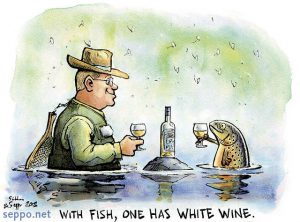 If you are sufficiently enlightened to avoid the “I only drink red wine” trap, your options are much broader and quite frankly, better. The inherent differences between the two types of grape along with the different methods of winemaking, ensure that many more white wines fulfil the criteria above than their more opaque-colored siblings. High acidity, relatively low alcohol, basically non-existent tannins and a more affordable price point are the hallmarks of good white wines.
If you are sufficiently enlightened to avoid the “I only drink red wine” trap, your options are much broader and quite frankly, better. The inherent differences between the two types of grape along with the different methods of winemaking, ensure that many more white wines fulfil the criteria above than their more opaque-colored siblings. High acidity, relatively low alcohol, basically non-existent tannins and a more affordable price point are the hallmarks of good white wines.
From a versatility perspective, Pinot Noir’s white wine counterpart is Riesling, which for years represented the kosher wine world’s holy grail. Thankfully these days there are more than a handful of solid choices, including a number hailing from the genre’s homeland of Germany. For now only the Nik Weis outlined below is available in the US (the 2016 is the third kosher vintage for this wine, and the best yet), but the winery’s higher-ranked options are headed our way as well. For those who understandably prefer to avoid German wines, there are some nice options from Alsace, Israel (Carmel and Vitkin) and California (Hagafen) as well.
Another easy-drinking wine that plays nice with many dishes is Pinot Grigio. While usually regulated to the summer due to its extremely light-bodied nature and lack of complexity, there are some nice options that hit the spot and hail from around the globe. Israel (Golan Heights Winery’s Yarden option, Gvaot and Dalton) and Italy (Borgo Reale and Cantina Gabriele) have some nice options. Another wine that is oft-suggested for challenging pairing environments is Gewürztraminer, especially when dealing with spicy or other Asian flavors. Personally, given the wine’s assertive flavors and personality, it is more of a hate it or love it wine, making it difficult to recommend for this type of meal. If you are in the “love it” camp, solid versions are produced by Koenig, Lueria and the Golan Heights Winery, under the Yarden label. ElviWine’s InVita, Bone-dry Sauvignon Blanc (Covenant, Hagafen, O’Dwyers Creek and Goose Bay) and unoaked Chardonnay (Domaine Les Marronniers) are other decent options. Chenin Blanc would do in a pinch as well (Dalton and Domaine Netofa)
Contrarian and Perfect
 While somewhat non-conforming, Rosé is one of the best pairing options out there. Like Riesling, it hits all the high notes for the meal while also having wider appeal than its Germanic cousin. As you all know, I wholeheartedly agree with Eric Asimov and strongly recommend enjoying Rosé all year round, with its extreme versatility providing a tailor-made solution to nearly any wine and food-pairing conundrum and its glorious color will complement your table beautifully. Having achieved a level of popularity so extreme that it has been rendered “uncool” by some misanthrope wine snobs, wine producers have risen to the occasion and we are blessed with a myriad of great options, most of which I reviewed earlier this year.
While somewhat non-conforming, Rosé is one of the best pairing options out there. Like Riesling, it hits all the high notes for the meal while also having wider appeal than its Germanic cousin. As you all know, I wholeheartedly agree with Eric Asimov and strongly recommend enjoying Rosé all year round, with its extreme versatility providing a tailor-made solution to nearly any wine and food-pairing conundrum and its glorious color will complement your table beautifully. Having achieved a level of popularity so extreme that it has been rendered “uncool” by some misanthrope wine snobs, wine producers have risen to the occasion and we are blessed with a myriad of great options, most of which I reviewed earlier this year.
 Achron Achron Chaviv is another wine which simply cannot get the love and respect it deserves. Despite being the epitome of versatility and representing the height of vino-awesomeness, Champagne and other sparkling wines are severely under-represented at our dinner tables. A superbly appropriate wine with which to thank anyone insane enough to host a Thanksgiving dinner, it is virtually guaranteed to be appreciated by any potential recipient while also being a near-perfect match to pretty much anything and a great way to begin any festive occasion. As an added bonus the lively bubbles awaken your palate in the most magnificent way. Whether as a gift for someone else or a reward for all your hard work and regardless of whether your menu includes ten meticulously-prepared courses or greasy Chinese take-out, sparkling wine is a foolproof bet for easy pairing and should be represented at every meal but certainly one as festive as Thanksgiving dinner.
Achron Achron Chaviv is another wine which simply cannot get the love and respect it deserves. Despite being the epitome of versatility and representing the height of vino-awesomeness, Champagne and other sparkling wines are severely under-represented at our dinner tables. A superbly appropriate wine with which to thank anyone insane enough to host a Thanksgiving dinner, it is virtually guaranteed to be appreciated by any potential recipient while also being a near-perfect match to pretty much anything and a great way to begin any festive occasion. As an added bonus the lively bubbles awaken your palate in the most magnificent way. Whether as a gift for someone else or a reward for all your hard work and regardless of whether your menu includes ten meticulously-prepared courses or greasy Chinese take-out, sparkling wine is a foolproof bet for easy pairing and should be represented at every meal but certainly one as festive as Thanksgiving dinner.
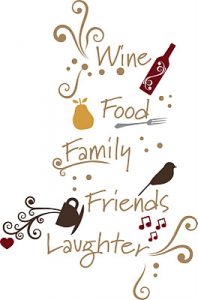 In addition to the various specific recommendations sprinkled throughout the newsletter, I have listed some specific options below that would all do serious justice to your holiday table. As time is fast running out, the list focused on wines that are more likely to be widely available (not all the wines mentioned above fall into that criteria).
In addition to the various specific recommendations sprinkled throughout the newsletter, I have listed some specific options below that would all do serious justice to your holiday table. As time is fast running out, the list focused on wines that are more likely to be widely available (not all the wines mentioned above fall into that criteria).
The most important thing to remember (besides not to run out of wine) is that tomorrow is a day to be thankful for all we have and those we are lucky enough to share it with. When all is said and done, choosing holiday wine(s) is about what you prefer and think your guests will enjoy – not finding the “right” wine. Focusing on relaxing, enjoying the company and basking in the warmth of having provided your guests with a wonderful experience (something for which wine is obviously a prerequisite) is the way to go.
Shabbat Shalom and a very Happy Thanksgiving!
Yossie
 Sparkling
Sparkling
- Drappier, Carte D’Or, n.v. (mevushal)
● Golan Heights Winery, Yarden, Blanc de Blancs, 2009
Rosé
- Castel, Rosé, 2016
● Psagot, Rosé, 2016
● Ramon Cardova, Rosé, 2016
White
- Hagafen, Dry Riesling, Rancho Wieruszowski, 16 (mevushal)
● O’Dwyer’s Creek, Sauvignon Blanc, 2016 (mevushal)
● St. Urbans-Hof, Nik Weis, Gefen Hashalom, 2016
Red
- Damian Gachot-Monot, Bourgogne, 2010
● Domaine La Ferrage, Cote De Brouilly, Beaujolais, (Louis Blanc), 2013
● Gvaot, Gofna, Pinot Noir, 2014